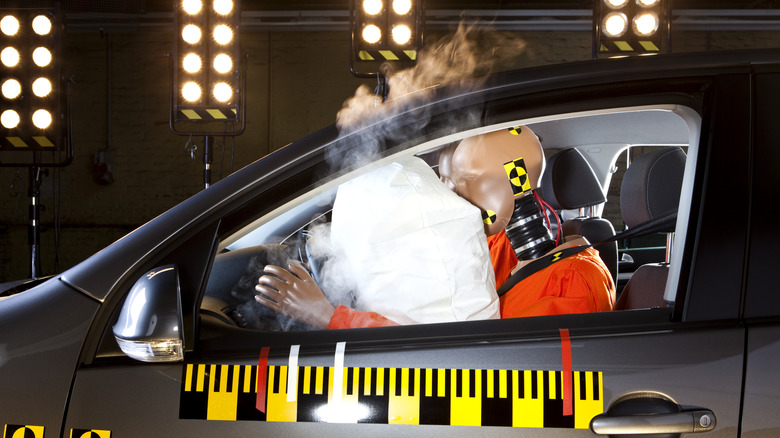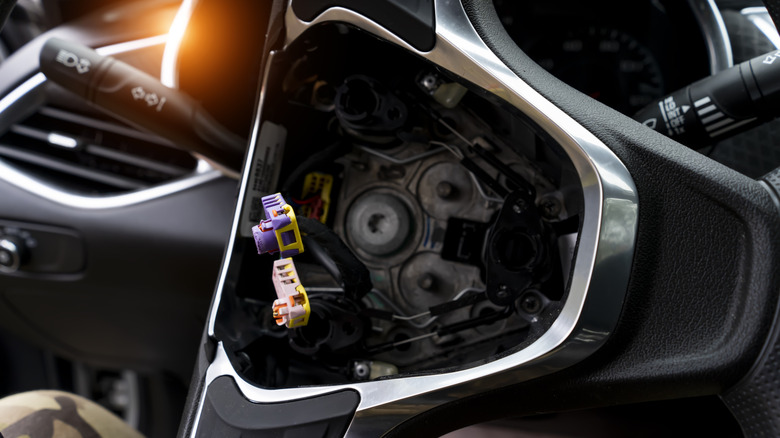What's The Powder Inside Airbags? (And Is It Dangerous?)
If you've ever had an airbag go off in your face or seen one deploy, you may have noticed a distinctive cloud of powdery substance pop off the bag in a little cloud in the process. This substance is a powder that coats the outer shell of the bag, though in addition to that outer powder, there is also an inner powder responsible for the bag's actual deployment.
Contrary to what you might expect, an automotive airbag is not like a balloon inflated by air or helium, at least not at first. The inside of the bag contains an isolated canister, which is full of a powdered chemical called sodium azide. When sodium azide is exposed to a powerful spark, it rapidly transforms into a gaseous state, which instantly inflates and deploys the airbag.
When the discussion turns to chemicals and gases, it's natural to wonder whether or not they could be potentially harmful to human life in the immediate vicinity. That sodium azide present in the airbag's inflation module is definitely harmful to human life, but the good news is that, due to the precise way in which it's utilized, your odds of actually being exposed to it are fairly low.
There is talcum powder outside the bag and sodium azide inside
Briefly, let's go over the identities of the powders inside of the airbag and what they're there for. Firstly, the powder on the outside of the airbag is not sodium azide. Rather, it's either talcum powder or cornstarch, the same kind of stuff you'd find in your pantry. Automotive manufacturers cover the outer layer of an airbag with these kinds of powders to help keep them lubricated, which ensures that they deploy cleanly when they need to. While it may seem like a cloud of some kind of smoke is released when the bag deploys, that's just talcum powder being launched into the air and settling.
The powder on the inside of the airbag is sodium azide, isolated within a sealed canister inside the bag itself. When your vehicle detects a sudden jolt of force at high speed and needs to deploy the airbag, a quick, powerful spark fires off into the sealed canister from an ignition module. When it's exposed to this heat, sodium azide undergoes a rapid chemical shift, instantly transforming into nitrogen gas. This instant shift from solid to gas is what causes the airbag to quickly inflate with intense force.
The internal powder is dangerous, but your odds of exposure are low
The talcum powder or cornstarch that's scattered when the airbag is deployed is generally harmless on its own. It can be an irritant if it gets into your eyes, but it's nothing a quick rinse with water won't fix. You should also wash your hands with soap and water after handling an airbag for that same reason.
As for the sodium azide sealed within the airbag, that technically warrants a little more caution. Sodium azide is very much a harmful substance to human life, as its presence inhibits a living cell's vital processing of oxygen. If you were to inhale sodium azide gas or swallow it as a solid, your body's cells could rapidly begin failing, which would swiftly begin to affect your brain and heart. The good news is that, due to the design of an airbag and the way sodium azide is actually used, your odds of being exposed to it are very low, even if the bag deploys.
The sodium azide is isolated from the rest of the car within an extremely sturdy sealed metal canister, which is also housed within an additional protective housing inside the steering wheel. These components are part of why airbags are so expensive to replace. More importantly, when the airbag deploys and the sodium azide undergoes its chemical shift, it's completely used up to inflate the bag. Even if the bag were to be opened after deployment, all that would be in there is nitrogen, which is completely harmless to humans. The only potential scenario where you could be exposed to sodium azide from an airbag would be if the airbag ruptures without actually deploying, which could be more of a concern if you bought a used (but undeployed) airbag.


